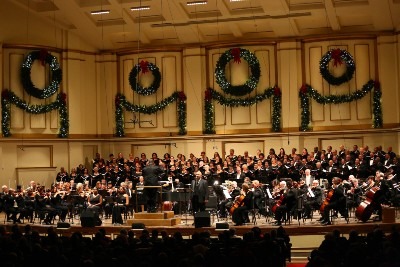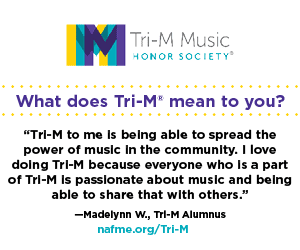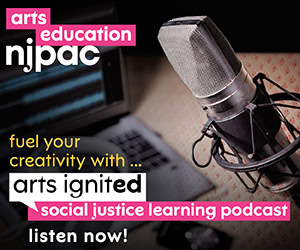/ News Posts / The St. Louis Symphony IN UNISON Chorus: Bridging the Divide
The St. Louis Symphony IN UNISON Chorus
Bridging the Divide
By NAfME Member Brandon Williams
This article first appeared in the June 2022 Music Educators Journal.
St. Louis, Missouri, is home to many nationally recognized cultural institutions. Like many others in the United States, it is also a city highly segregated along racial lines. Delmar Boulevard is a street in St. Louis that divides the city as to race, class, and socioeconomic status.1 Powell Hall, the home of the Grammy–Award–winning St. Louis Symphony Orchestra, sits at the corner of Delmar Boulevard and Grand Avenue on the affluent side of the street. Historically, the doors of many orchestra halls and other classical music venues have functioned as a metaphorical divide that has excluded audiences and performers of color.2 The St. Louis Symphony Orchestra works to bridge the divide by instituting a multifaceted community engagement program called the IN UNISON Program that addresses the historical exclusion of Black, Indigenous, and People of Color (BIPOC) performers and audience members in their community. Part of that program includes the St. Louis Symphony IN UNISON Chorus—the “first resident chorus in the country to specialize in the preservation and performance of music with African and African American origins.”3 The chorus provides opportunities for the symphony to be relevant in the musical life of the community where it resides and champions new music that fuses the gospel and symphonic traditions.
Community building is a vital goal of any music classroom or ensemble. Music educator Juliet Hess draws on the work and experiences of activist-musicians and affirms that musicking brings us together “through shared emotion, through using music to build bridges between people, through intentionally placing people together, through learning when to assert one’s voice musically and when to support others, and through engaging with unfamiliar music.”4 This perspective, as embodied by the IN UNISON Program, can serve as a model for music educators who want to reconsider their practices and build community with historically excluded students.
History of the Organizations
The St. Louis Symphony Orchestra is America’s second-oldest professional symphony orchestra. Joseph Otten founded it in 1880 as the St. Louis Choral Society, and by 1893, it was known as the St. Louis Choral-Symphony. Their current name was adopted in 1907. The St. Louis Symphony Orchestra (SLSO) has won seven Grammy Awards and has been led by many notable music directors, including Leonard Slatkin, Hans Vonk, David Robertson, and the current artistic director, Stéphane Denève. Powell Hall, named after a wealthy local business executive who made a substantial donation to the organization, has been home to the St. Louis Symphony Orchestra since 1968. The IN UNISON Chorus was formed in 1994 when Robert Ray recruited African American singers from local churches and universities to perform Hannibal Lokumbe’s oratorio African Portraits, led by then SLSO assistant conductor André Raphel. That group of singers was expanded and officially became a part of the symphony organization with Robert Ray serving as the conductor until 2010. Kevin McBeth, the current conductor, is only the second individual to lead the choir in its twenty-eight-year history.
IN UNISON Program and Chorus
The St. Louis Symphony IN UNISON Program is a community engagement initiative that includes the IN UNISON Church Program, the IN UNISON Academy, and the IN UNISON Chorus. The Church Program was formed in conjunction with the St. Louis Clergy Coalition in 1992.5 Places of worship can apply for membership and, once accepted, are eligible for an in-person performance given by members of the orchestra. Members of IN UNISON churches also receive exclusive discounted tickets for St. Louis Symphony concerts. The Church Program, as it is known, is currently at capacity, comprising thirty-three predominantly African American churches throughout the St. Louis Metropolitan area. The IN UNISON Academy offers numerous scholarships, fellowships, and mentorships that are available for African American students in middle school through college. Financial support for the IN UNISON Program has consistently been provided by the Bayer Fund, a branch of the company formerly known as Monsanto.6
The St. Louis Symphony IN UNISON Chorus is an auditioned ensemble predominantly made up of African American singers from gospel choirs at participating IN UNISON churches. The 125-member choir rehearses one day a week, and each season they perform three concerts with the SLSO. The Gospel Christmas and Black History Month concerts are performed in Powell Hall and include Black celebrity guest artists who headline the performances. Notable celebrities include Cece Winans, Take 6, Jennifer Holliday, Larnell Harris, Jenifer Lewis, and Whitley Phipps. The Spring Community Concert occurs at a participating IN UNISON church and features a guest conductor from the Black community. Moses Hogan, André Thomas, Rosephanye Powell, and Jeffrey Ames are some conductors who have led that concert. Choir members demonstrably take pride in their concerts and perform a variety of musical styles. Although most of the members are not professionals, the IN UNISON Chorus has been home to some individuals who have continued careers in music. Rollo Dilworth and soprano Marlissa Hudson were both charter members of the choir, and I served as the assistant conductor from 2011 to 2013.
Choir Membership and Singing in the Black Church
On June 26, 2015, President Obama delivered the eulogy for Reverend Clementa Pinckney, the lead pastor and one of nine people murdered while attending Bible study at Mother Emanuel African Methodist Episcopal Church in Charleston, South Carolina. He concluded his remarks by singing what seemed to be an impromptu rendition of “Amazing Grace.” Clergy members behind the pulpit quickly stood to their feet and, with the congregation, added their voices to his. The instrumentalists identified the key and provided accompaniment by the end of the first phrase.7 This well-documented experience demonstrates the participatory and sometimes spontaneous nature of singing and worship in the Black Church.
The vast majority of members in the IN UNISON Chorus also sing in local church gospel choirs, creating an ensemble ethos primarily formed around the Black gospel tradition and Black Church culture. Singing in the Black Church is a communal activity that permeates many elements of the worship experience. According to theologian James Cone, “Black music is unity music. It united the joy and sorrow, the love and the hate, the hope and despair of Black people. . . . It shapes and defines Black being and creates cultural structures for Black expression.”8
Choral singing also plays a vital role in the Black worship experience. Gospel music and gospel choirs are found in many Black churches, particularly in urban areas. The vocal writing for gospel choirs is commonly scored for three voice parts (soprano, alto, tenor), and the accompanying forces usually consist of a standard rhythm section (keyboard, bass, drum set) with the Hammond organ as a typical keyboard addition or substitution.9
“Gospel Symphonic” Music
Many of the features mentioned previously that are central to music in the Black Church do not translate to the classical genre, so there are few compositions available that are ideal for this fusion of styles. “Gospel symphonic” refers to works scored for SATB chorus, rhythm section, Hammond organ, and full orchestra. The St. Louis Symphony IN UNISON Chorus has commissioned Black composers to write new music in this style. One of the earliest commissions is a setting of “Sweet Little Jesus Boy” by St. Louis composer Malcolm Speed. Rollo Dilworth’s “Freedom’s Plow” was commissioned in honor of the choir’s fifteenth anniversary, and the Isaac Cates piece, “It’s Working,” was commissioned for the twenty-fifth anniversary. Nathalie Joachim, a Haitian American composer, wrote “Family” for the 2021–2022 season.
A Model for Bridging the Divide
In the early 1990s, the American Symphony Orchestra League hired The Wolf Organization, a consulting firm, to “arrive at a better understanding of the orchestra industry and to help the field plan for its future.”10 The findings in the 1992 report included dire financial projections and ten questions that challenged the industry’s status quo with the hope of avoiding the crisis. The fifth question focused on race and class in the industry:
How much longer can American orchestras remain all-white, upper-class institutions? There is a reason why our audiences are all white. It is because only 3% of our trustees and 2% of our players are black. Go to a performance of the Alvin Ailey Company or the Dance Theatre of Harlem and the experience is very different. Where an arts organization is truly representative of people of color, when people of color are on stage, there is a multi-cultural audience, even for what is often regarded as an elite European art form. And, painful as it may be, orchestras will have to acknowledge that they have established class and social barriers in their governance and volunteer structures that exclude people who are not white people of means. Orchestras can no longer afford to do this. Even those who may not believe it is just plain wrong to be exclusionary in this way should be forewarned that orchestras cannot continue to capture the public and private philanthropic dollar if their organizations are not truly integrated. Funders are simply losing patience.11
The St. Louis Symphony Orchestra was not a member of the American Symphony Orchestra League Policy Advisory Group affiliated with the “Wolf Report,” and it is unclear if any of the findings directly impacted the creation of the IN UNISON program. Regardless, this decades-old commentary on the industry’s lack of diversity and equity is still relevant today.
The work of the St. Louis Symphony IN UNISON Program carries more urgency because it takes place in a city with a long history of racial tension, segregation, and protests.12 The civil unrest in Ferguson, Missouri, a north St. Louis suburb where police fatally shot Michael Brown, thrust the relationship between law enforcement and the African American community and the city of St. Louis into the national spotlight. The St. Louis Symphony IN UNISON Program is highlighted as a long-standing model for outreach that is invested in institutional change and improving access to the symphony hall for performers and audience members. The League of American Orchestras (formerly the American Symphony Orchestra League) recently awarded the St. Louis Symphony Orchestra a grant to “strengthen its understanding of equity, diversity, and inclusion (EDI) and to help transform organizational culture.”13
The St. Louis Symphony IN UNISON Program has a choir as its most visible element, but other programs with similar aims feature instrumental ensembles. The Sphinx Organization is a Detroit-based social justice performing arts entity that supports six instrumental ensembles/programs and one professional vocal ensemble. Their main programs (Education & Access, Artist Development, Performing Artists, and Arts Leadership) focus on “increasing representation of Black and Latinx artists in classical music and recognizing excellence.”14
The St. Louis Symphony IN UNISON Chorus and Program, and similar groups such as The Sphinx Organization, can be models for institutions that endeavor to “bridge the divide.” By enacting robust initiatives, these institutions have facilitated meaningful engagement of BIPOC audiences, the promotion of BIPOC performers and composers through programmatic choices, partnerships with community-serving organizations to find new relevancy, and financial support for students.
Notes
1.Jason Purnell, Gabriella Camberos, and Robert Fields, eds., For the Sake of All: A Report on the Health and Well-Being of African Americans in St. Louis and Why It Matters for Everyone (St. Louis, MO: Health Equity Works, 2014), 28–29.
2.Aaron Flagg, “Anti-Black Discrimination in American Orchestras,” Symphony 71, no. 3 (2020); League of American Orchestras, “Statement on Racial Discrimination,” June 25, 2020.
3.St. Louis Symphony Orchestra, “History of the St. Louis Symphony Orchestra.”
4.Juliet Hess, Music Education for Social Change: Constructing an Activist Music Education (New York, NY: Routledge, 2019), 42.
5.St. Louis Symphony, “SLSO IN UNISON.”
6.St. Louis Symphony, “St. Louis Symphony Orchestra Receives $160,000 Grant from Bayer Fund,” July 20, 2020.
7.Barack Obama, “President Obama Delivers Eulogy,” filmed June 17, 2015, video, 35:00.
8.James H. Cone, The Spirituals and the Blues: An Interpretation (New York: Seabury Press, 1972), 5.
9.Raymond Wise, “Defining African American Gospel Music by Tracing Its Historical and Musical Development from 1900 to 2000” (PhD diss., The Ohio State University, 2002), 93–94. Wises’s dissertation provides a comprehensive exploration on the development of the vocal and instrumental forces in gospel music.
10.The Wolf Organization, The Financial Condition of Symphony Orchestras (Cambridge, MA: The Wolf Organization, Inc., 1992), i.
11.Ibid., A 19.
12.Jeannette Cooperman, “The History of Protests in St. Louis,” St. Louis Magazine, November 2017. http://projects.stlmag.com/the-history-of-protests-in-st-louis
13.League of American Orchestras, “The Catalyst Fund: Advancing Equity, Diversity and Inclusion in American Orchestras.”
14.Sphinx, “About the Sphinx Organization.”
About the author:

Photo by Elizabeth Schneider
Brandon Williams is an associate professor of choral music and choral music education at Rutgers, The State University of New Jersey, in New Brunswick. He can be contacted at bwilliams@mgsa.rutgers.edu.
Did this blog spur new ideas for your music program? Share them on Amplify! Interested in reprinting this article? Please review the reprint guidelines.
The National Association for Music Education (NAfME) provides a number of forums for the sharing of information and opinion, including blogs and postings on our website, articles and columns in our magazines and journals, and postings to our Amplify member portal. Unless specifically noted, the views expressed in these media do not necessarily represent the policy or views of the Association, its officers, or its employees.
Published Date
August 23, 2022
Category
- Culture
- Diversity, Equity, Inclusion, and Access (DEIA)
- Race
- Representation
Copyright
August 23, 2022. © National Association for Music Education (NAfME.org)





